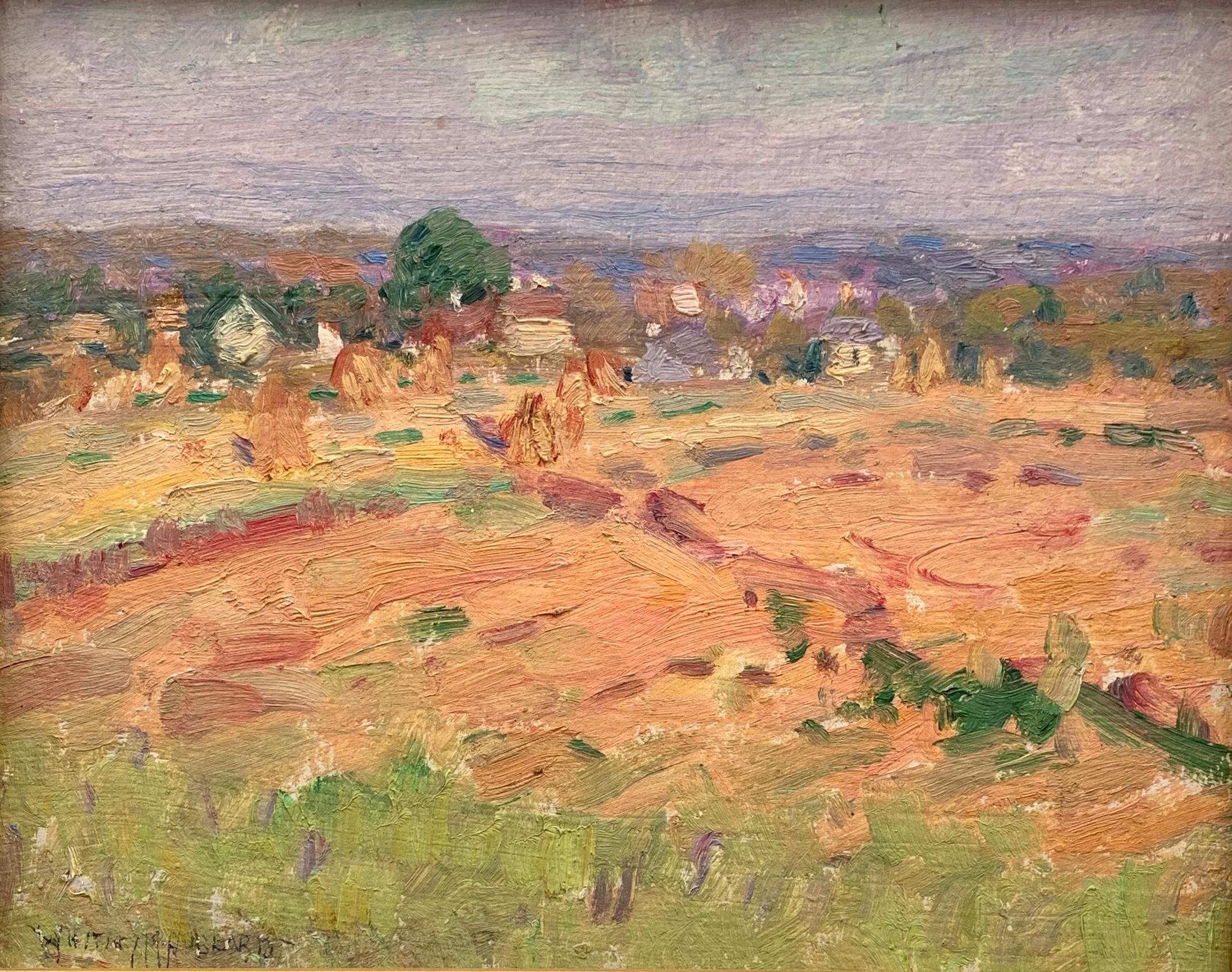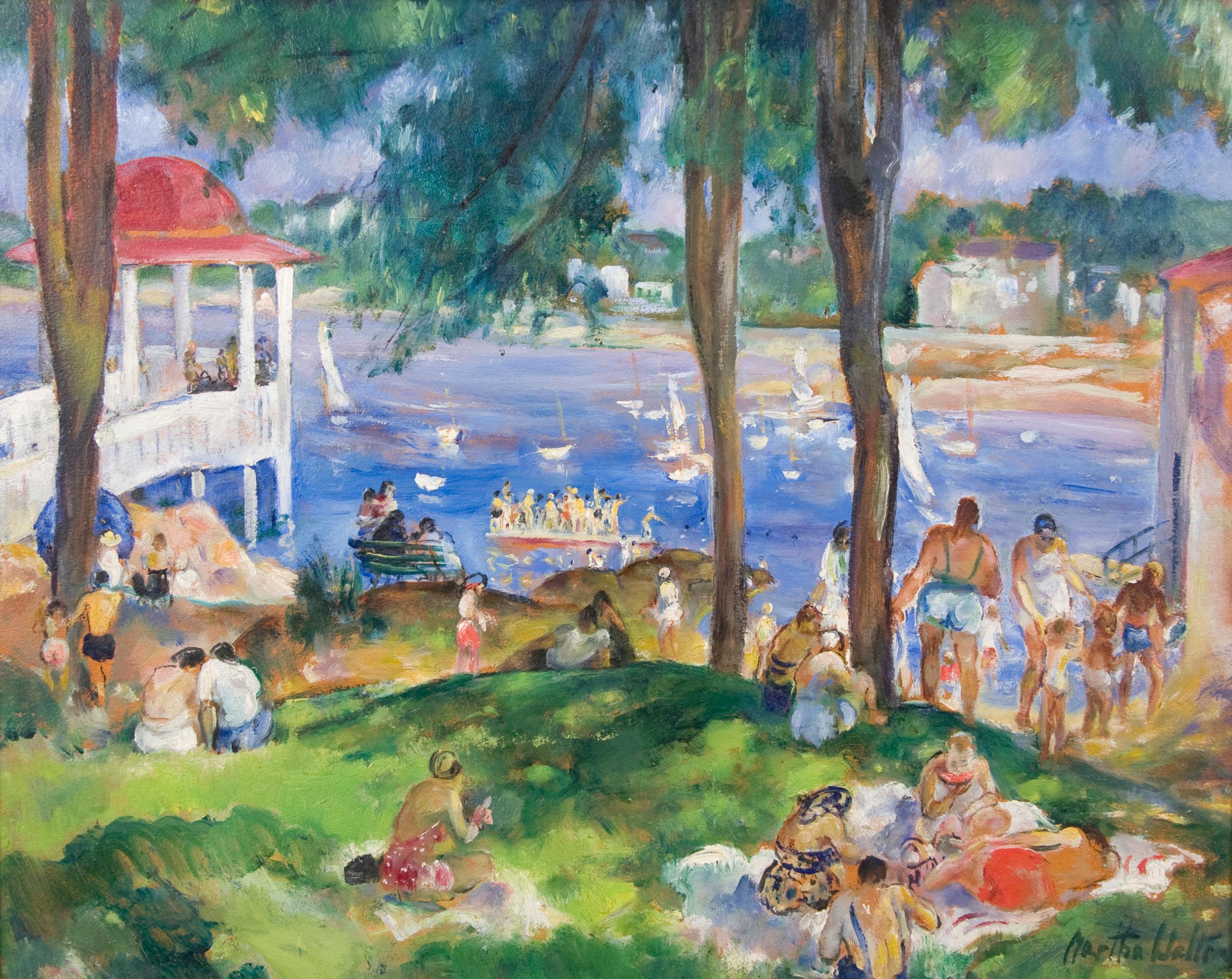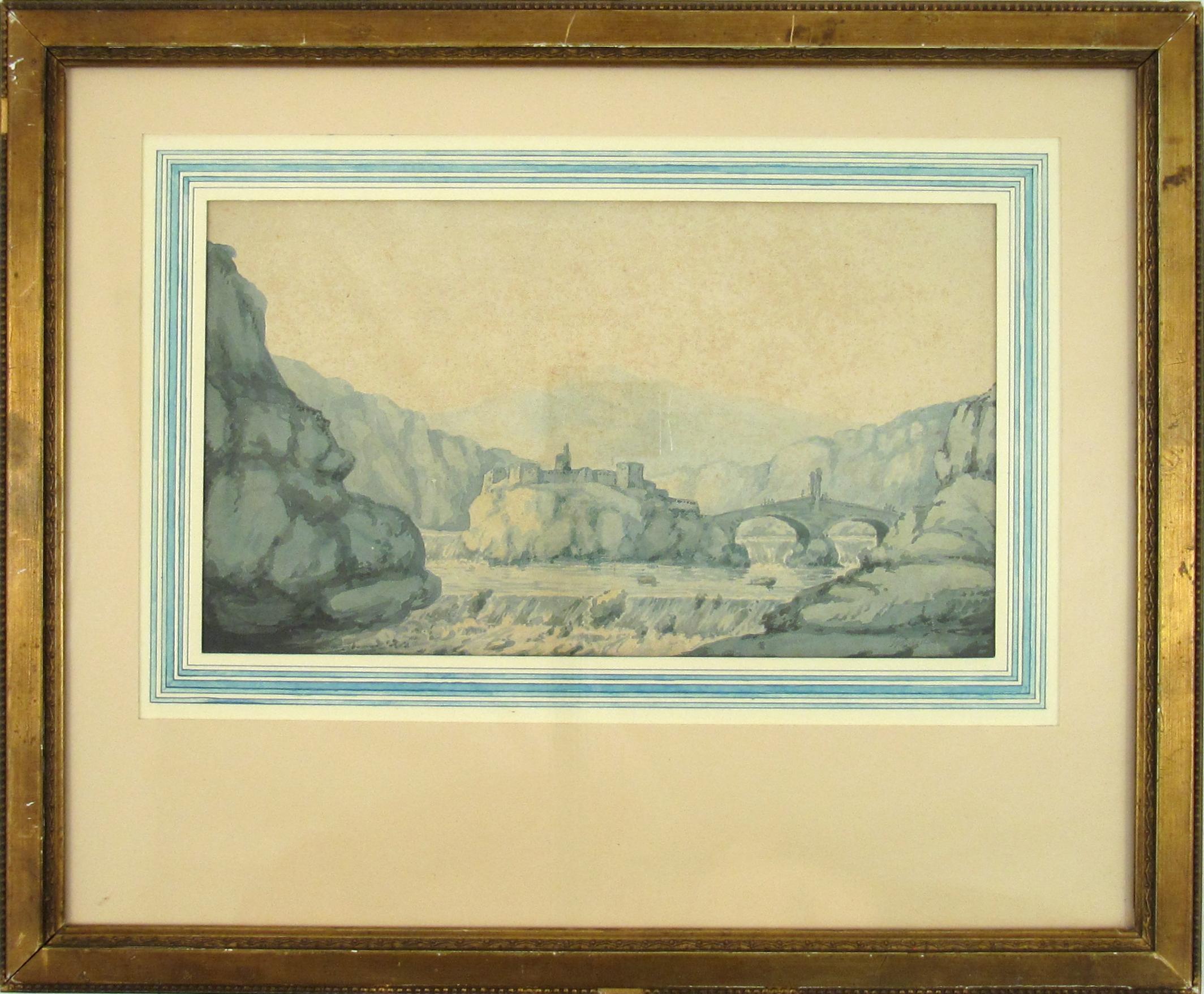Items Similar to Low Mountain Landscape with Rocks - The mystery of an inconspicuous place -
Want more images or videos?
Request additional images or videos from the seller
1 of 9
Heinz RoderLow Mountain Landscape with Rocks - The mystery of an inconspicuous place -1934
1934
About the Item
Heinz Roder (1895-1965), Low Mountain Landscape with Rocks, oil on painting cardboard, 30 x 40 cm (visual size), 40 x 50 cm (frame), signed and dated "[19]34" at lower right. In a decorative stucco frame of the period.
- Small chip at lower left margin, craquelure in the upper area.
About the artwork
Heinz Roder depicts a low mountain range landscape, but there is no mountain panorama or distant view. He takes us to a place just below the tree line, on the crest of a hill. The fir trees descending into the background make it clear that it is downhill again. Instead of a view of the surrounding landscape, there is a huge rock in the foreground which, together with the firs, restricts the view. Roder transforms what is normally a wide mountainous landscape into a close-up view, following the eighteenth-century practice of blocking the view in order to enhance the intimacy of the depicted idyll.
Here, however, we are not looking at a locus amoenus, the beautiful place of a restored paradise, but at a rugged landscape with mighty rocks, as it appears in the play of colours. The blue-grey rocks and the ochre-yellow grasses are contrasted by the blue-yellow sky. With the blue-gray rocks and the ocher-yellow grasses the blue-yellow complementary contrast is leading, in which also the sky inserts itself. There is also the dark green of the fir trees, which combines with the mossy growth of the rocks.
With a very reduced palette, Roder has succeeded in creating a colour harmony rich in tension, which also incorporates the contrast in the texture of the landscape: the delicate soft grasses flow around the hard rock formation. Roder evokes these material qualities with a free, almost sketchy, impressionistic line. The grasses are vertically oriented, quick successions of strokes, while the rocks are horizontal layers of strokes. This creates a fluctuating moment that gives the landscape its specific liveliness and brings the aura of the place into the picture.
Thank you for your interest! I hope I have been able to explain to you the special character of the artwork. If you have any questions of any kind, please feel free to contact me.
I wish you many more discoveries in the realm of art,
Dr Martin Kirves
GERMAN VERSION
Heinz Roder (1895-1965), Mittelgebirgslandschaft mit Felsen, Öl auf Malkarton, 30 x 40 cm (Sichtmaß), 40 x 50 cm (Rahmen), unten rechts signiert und "[19]34" datiert. In dekorativem Stuckrahmen der Zeit.
- kleine Abplatzung im unteren linken Randbereich, Craquele im oberen Bereich
zum Werk
Heinz Roder veranschaulicht eine Mittelgebirgslandschaft, die allerdings kein Bergpanorama oder einen Ausblick in die Ferne zeigt. Er versetzt uns an einen etwas unterhalb der Baumgrenze angesiedelten Ort auf der Kuppe einer Anhöhe. Die in den Hintergrund hinein absteigenden Tannen verdeutlichen, dass es dort wieder bergab gehen wird. Anstelle der Aussicht in die umliegende Landschaft erhebt sich im Bildvordergrund ein mächtiger Felsen, der zusammen mit den Tannen das Blickfeld begrenzt. Roder wandelt die üblicherweise weite Gebirgslandschaft in eine nahsichtige Szenerie und folgt damit der sogenannten gesperrten Landschaft des 18. Jahrhunderts, die den Blick im Nahbereich hält, um die Intimität der dargestellten Idylle zu steigern.
Hier sehen wir jedoch nicht einen locus amoenus, den lieblichen Ort eines wiederhergestellten Paradieses, sondern beschauen die mit dem mächtigen Felsen durchaus raue, von archaischen Kräften geprägte Landschaft wie sie sich im Spiel der Farben darbietet. Mit den blaugrauen Felsen und den ockergelben Gräsern ist dabei der Blau-Gelb Komplementärkontrast leitend, in den sich auch der Himmel einfügt. Hinzu kommt das sich mit dem moosartigen Bewuchs des Felsens verbindende Dunkelgrün der Tannen.
Mit einer stark reduzierten Palette gelingt es Roder, eine in sich spannungsreiche Farbharmonie zu erzeugen, in die auch der Kontrast der Beschaffenheit der Landschaft eingeht: Die filigranen weichen Gräser umfließen die harte Felsformation. Diese materiellen Qualitäten evoziert Roder mit einem freien, beinahe skizzenhaften impressionistischen Duktus. Die Gräser sind vertikal ausgerichtete schnelle Strichfolgen, während die Felsen aus horizontalen Strichschichtungen bestehen. Dadurch entsteht ein fluktuierendes Moment, das der Landschaft ihre spezifische Lebendigkeit verleiht und die Aura des dargestellten Ortes ins Bild setzt.
Vielen Dank für Ihr Interesse! Ich hoffe, ich habe Ihnen den besonderen Charakter des Kunstwerks näherbringen können. Bei Fragen jeglicher Art können Sie mich gerne kontaktieren.
Ich wünsche Ihnen noch viele Entdeckungen im Reich der Kunst,
Dr. Martin Kirves
- Creator:Heinz Roder (1895 - 1965, German)
- Creation Year:1934
- Dimensions:Height: 11.82 in (30 cm)Width: 15.75 in (40 cm)
- Medium:
- Period:
- Condition:
- Gallery Location:Berlin, DE
- Reference Number:1stDibs: LU2438212304052

About the Seller
5.0
Vetted Seller
These experienced sellers undergo a comprehensive evaluation by our team of in-house experts.
Established in 2014
1stDibs seller since 2023
7 sales on 1stDibs
Typical response time: 6 hours
- ShippingRetrieving quote...Ships From: Berlin, Germany
- Return PolicyA return for this item may be initiated within 14 days of delivery.
More From This SellerView All
- Sunny woodland path - A brightly lit forest path as a space for imagination -Located in Berlin, DEWilhelm Schütze (1840 Kaufbeuren - 1898 Munich). Forest path. Oil on painting board, 30 x 24 cm (visible size), 31 x 26 cm (frame), signed lower left "Wilhelm Schütze". About the a...Category
1880s Naturalistic Landscape Paintings
MaterialsOil, Cardboard
- Autumn Landscape in Sunlight - Indian Summer -Located in Berlin, DEFrederick Vezin (1859 Torresdale Philadelphia - 1933 Düsseldorf), Autumn Landscape in the Sunlight, oil on canvas, mounted on cardboard, 32 x 41 cm (inside measurement), 44 x 51 cm (...Category
Early 1900s Impressionist Landscape Paintings
MaterialsOil, Cardboard
- Two countrywomen with a donkey - Melancholy in an atmosphere of colour -Located in Berlin, DEPierre Louis De La Rive (1753 Geneva - 1817 Geneva). Two countrywomen with a donkey. Oil on canvas, mounted, 27 x 20 cm (visible size), 37 x 31 (frame), monogrammed "P.R." at lower right. About the artwork De La Rive has taken the typical scenes of Dutch landscape genre paintings...Category
1790s Old Masters Figurative Paintings
MaterialsCanvas, Oil
- Landscape with Trees by a Lake - Eternal summer silence over an abysmal lake -Located in Berlin, DEAndreas Thomas Juuel (1816 Copenhagen - 1868 Copenhagen). Summer landscape with tall deciduous trees by a lake. Oil on canvas, 54,5 x 42 cm (visible size), 71 x 58 cm (frame), signed...Category
1850s Realist Landscape Paintings
MaterialsOil
- Children with geese in the light of a summer eveningLocated in Berlin, DEMagda Kremer (*1942 Hengelo), Children with geese in the light of a summer evening. Oil on canvas, 40 x 50 cm (inside measurement), 52 x 62 cm (frame), signed by hand with "M.[agda] ...Category
Mid-20th Century Realist Figurative Paintings
MaterialsOil
- Late Summer River Landscape / - Realistic Impression -By Jan Hillebrand WijsmüllerLocated in Berlin, DEJan Hillebrand Wijsmuller (1855 Amsterdam - 1925 ibid.), Late Summer River Landscape, oil on canvas, relined, 34 x 56 cm (inside measurement), 43 x 64 cm (frame), signed J[an] H[illebrand] Wijsmuller at lower right. - in good condition, the frame with isolated bumped spots - Realistic Impression - About the artwork The panoramic landscape format shows a river landscape, with the course of the river, which curves to the right, leading the eye into the depths of the picture and tempting it to continue the landscape in the imagination beyond the visible area. At the same time, however, the fact that the landscape is not visible through the bend in the river focuses our gaze on the entirety of the landscape depicted, without prompting us to focus on distant details. Accordingly, the brushstroke is not designed to render details with realistic precision. In the front left area of the river there is even a completely free brushwork, trained by Impressionism, which nevertheless remains committed to representational and convincingly suggests the movement of the water. Regardless of the distance of the observer, the entire picture is painted with the same broad brushstroke, so that the landscape is given as an impression. And yet this impression is not ephemeral, as in the case of French Impressionism, to put it exaggeratedly, but reveals to us the essence of the landscape in all its richness. This is why the Dutch variant of Impressionism is always also a realism, although the pictures appear less progressive, but still contain a dimension of landscape painting that is lost with progress. In the impression, the reality of the landscape is revealed, and this happens as we experience the landscape in the visual impression. Wijsmuller does not depict houses or people in order to allow the experience of the landscape to fully unfold. The experience is determined first and foremost by the river, which does not flow into the picture from our point of view, but towards us. Where the river begins to bend, the water is churned by a rapids. Toward us, the riverbed widens and the water comes to rest, covering the entire width of the foreground like a mirror. The stillness of the water corresponds to the evening mood of the late summer landscape, in which the warm tones of the evening light blend with the yellow and brown tones of the plants. A gentle, almost idyllic reality, carried by the brushstroke, yet animated by a liveliness that is also made visible by the brushstroke. The broad, dynamically placed brushstrokes evoke the movement of the treetops and animate even the immobile reeds, while the trunks on the right bank, executed in virtuoso white strokes that seem like markings, make the sunlight shine. On the other bank, a carpet of light also spreads out, its energetic effect again expressed in the brushstroke. The dynamic of the landscape is further enhanced by the complementary color contrasts between the greens, yellows, and browns on the one hand and the blue of the all-encompassing sky on the other. A contrast that is intensified by the reflection in the water. The evening coming to rest of the landscape is thus at the same time an all-encompassing contrasting and yet in itself harmonious movement. This reality becomes accessible to us as an experience in the impression of the landscape. About the artist Jan Hillebrand Wijsmuller entered the Royal Academy of Arts in Amsterdam in 1876 and studied under the innovative Professor August Allebé, who was famous for the Amsterdam Impressionism, also known as the Allebé School. In 1877, Wijsmuller transferred to the Hague Academy of Art, and thus to the Hague School, and then completed his studies at the Brussels Academy of Art. Returning to the Netherlands, Wijsmuller opened his own studio in Amsterdam. In 1883 he won the prestigious Young Artist Award, donated by Willink van Collen, which made Wijsmuller a well-known and sought-after artist. Wijsmuller was a member of the Societät Arti et Amicitiae Amsterdam and the Pulchri Studio in The Hague. Wijsmuller belongs to the second generation of the Hague School. While Vincent van Gogh described the protagonists of the first generation to his brother Theo as "the great gray people," the second generation, and Wijsmuller in particular, used a much more colorful palette. His oeuvre makes him a major player in Dutch Impressionism...Category
1890s Impressionist Landscape Paintings
MaterialsCanvas
You May Also Like
- “Hill View”By Whitney Myron HubbardLocated in Southampton, NYOriginal oil on heavy cardboard (old chocolate candy box cover) of a hill view landscape by Whitney Myron Hubbard. Signed lower left. Signed and titled verso. Circa 1930. Conditi...Category
1930s Post-Impressionist Landscape Paintings
MaterialsOil, Cardboard
- Ivan Sorokin. 1970 Winter landscape. Russian art Oil Painting.By Ivan SorokinLocated in Berlin, DEIvan Sorokin. Honoured Artist of the RSFSR, People’s Artist of the USSR, Member of the USSR Academy of Arts, Winner of the I. E. Repin State prize.Category
1970s Impressionist Landscape Paintings
MaterialsOil, Cardboard
- Tuck's Point, MassachusettsBy Martha WalterLocated in Washington, DCAmerican ImpressionistCategory
1940s American Impressionist Landscape Paintings
MaterialsOil Crayon, Cardboard
- Ralph R. Stubbs - Low tide at Sunset - English 19th Century Marine Oil PaintingBy Ralph Reuben / Ruben StubbsLocated in Meinisberg, CHRalph Reuben/Ruben Stubbs (English, 1824-1879) Low Tide at Sunset • 19thC Oil on artist board (card) ca. 21 x 36.5 cm • Signed bottom right and verso Biografie: Stubbs Ralph Reu...Category
1860s Impressionist Landscape Paintings
MaterialsOil, Cardboard
- William Daniell (British, 1769-1837) Fortification 19th Century Ink Wash DrawingBy William DaniellLocated in Meinisberg, CHWilliam Daniell (British, 1769-1837) Bridged Fortification in a Mountainous River • Blue wash on paper, laid on card, ca. 18 x 32 cm • Presented behi...Category
Early 19th Century English School Landscape Drawings and Watercolors
MaterialsWatercolor, Paper, Cardboard, Ink
- Riva d'Arno in FlorenceLocated in Roma, RMDomenico Bresolin (Padua 1813 - Venice 1890), Riva d'Arno in Florence Oil on canvas applied to cardboard 26 x 40 cm. INFO: to get more information Publications D. Ritter, Venedig...Category
Mid-19th Century Academic Landscape Paintings
MaterialsCanvas, Oil, Cardboard



